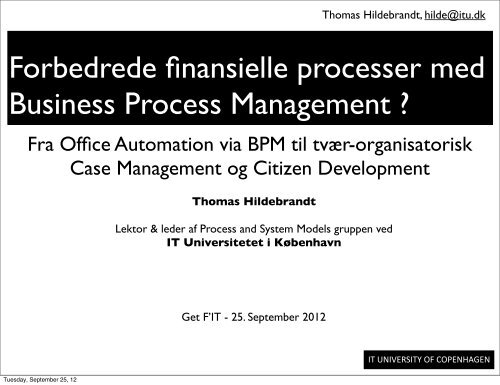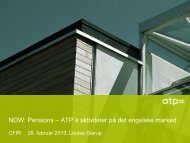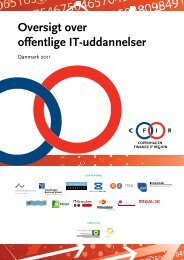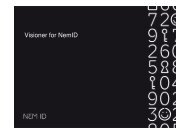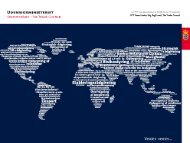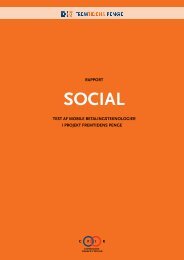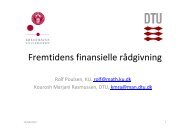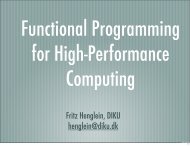ved Lektor Thomas Hildebrandt, IT Universitetet - CFIR
ved Lektor Thomas Hildebrandt, IT Universitetet - CFIR
ved Lektor Thomas Hildebrandt, IT Universitetet - CFIR
Create successful ePaper yourself
Turn your PDF publications into a flip-book with our unique Google optimized e-Paper software.
Get F’<strong>IT</strong>, BPM Seminar, 25. September, 2012<strong>Thomas</strong> <strong>Hildebrandt</strong>, hilde@itu.dkOverblik• State-of-the-art:Fra Office Automation til BPMN 2.0• Problemer/udfordringer:Planlægningsoptimisme, fleksibilitet, distribution• State-of-the-future:Case Management Modeling Notation (CMMN)Behavioral/Session TypesCitizen Developmentwww.itu.dk/research/modelsTuesday, September 25, 123<strong>IT</strong> UNIVERS<strong>IT</strong>Y OF COPENHAGEN
Get F’<strong>IT</strong>, BPM Seminar, 25. September, 2012<strong>Thomas</strong> <strong>Hildebrandt</strong>, hilde@itu.dkState-‐of-‐the-‐artHowever, the focus is not on data but on process-related information (e.g., the• Process-Aware Information Systems• A shift from data orientation toprocess orientation:Explicit process models• Business Process Model andNotation (BPMN) 2.0 - OMGStandard, 2011 (www.omg.org)ordering of activities). Process mining is also related to monitoring and businessintelligence [41].8 ConclusionProcess-aware information systems (PAISs) follow a characteristic life-cycle. Figure13 shows the four phases of such a life-cycle [7]. In the design phase, theprocesses are (re)designed. In the configuration phase, designs are implementedby configuring a PAIS (e.g., a WFMS). After configuration, the enactment phasestarts where the operational business processes are executed using the system configured.In the diagnosis phase, the operational processes are analyzed to identifyproblems and to find things that can be impro<strong>ved</strong>. The focus of traditional workflowmanagement (systems) is on the lower half of the life-cycle. As a result thereis little support for the diagnosis phase. Moreover, support in the design phase islimited to providing an editor while analysis and real design support are missing.Figure 13: PAIS life-cycle.In this article, we showed that PAISs support operational business processesby combining advances in information technology with recent insights from managementscience. We started by reviewing the history of such systems and thenfocused on process design. From the many diagramming techniques available, wechose one particular technique (Petri nets) to show the basics. We also emphasizedthe relevance of process analysis, e.g., by pointing out that 20 percent of the morethan 600 process models in the SAP reference model are flawed [24]. We also26www.itu.dk/research/modelsTuesday, September 25, 124<strong>IT</strong> UNIVERS<strong>IT</strong>Y OF COPENHAGEN
Get F’<strong>IT</strong>, BPM Seminar, 25. September, 2012<strong>Thomas</strong> <strong>Hildebrandt</strong>, hilde@itu.dkBPM eksempel“BPM on Top of SOA: Experiences from the Financial Industry”, BPM 2007 BestSteen Brahe, Industrial PhD, Danske Bank & <strong>IT</strong> University of CopenhagenIndustry Paper• Kundepakke: Forretningsprocess for salg afpakkeløsning: kreditkort, netbankadgang, ...• 10 forskellige systemer, 30 del-processer, 200service-kald/menneskelige opgaver.• Fra 200 pakker om dagen til 1800• 80% automatiseringwww.itu.dk/research/modelsTuesday, September 25, 125<strong>IT</strong> UNIVERS<strong>IT</strong>Y OF COPENHAGEN
Get F’<strong>IT</strong>, BPM Seminar, 25. September, 2012<strong>Thomas</strong> <strong>Hildebrandt</strong>, hilde@itu.dkBPM anno 1979• Office automation: Zisman & Hammer ’77,IBM Business Definition Language,Information Control Net (Ellis ’79 Xerox)z c:=Computer Science andOffice Information SystemsBy Clarence A. Ellis and Gary J. NuttORDER PROCESSINGCustomerRequestArrivalLog RequestType OrderOrderFormSend OrderReceive OrderIIJIBrocess-""I/Ir•/.rJIIA/ I'" I"+0I , Cus tamerJ j Fi leI:1.\•1IIIIJIIJIIIIIlLII Billing FileII ,lOut "tJ .1\:;;1lOut \. It Form '---- ----/--""',---- ... _------_ .. _-..,.-'F.igure 2www.itu.dk/research/modelsTuesday, September 25, 126<strong>IT</strong> UNIVERS<strong>IT</strong>Y OF COPENHAGEN
Get F’<strong>IT</strong>, BPM Seminar, 25. September, 2012<strong>Thomas</strong> <strong>Hildebrandt</strong>, hilde@itu.dkBPM anno 1979By considering the specification language, the internal representation, and the design of a prototype• Office automation: Zisman & Hammer ’77,simply as a collection of isolated tasks and pieces of equipment.IBM Business Definition Language,system using one unified model, Zisman has been able to study the office as a system rather thanlanguage and the model need refinement, his basic notions will probably have great impact on thez c:=Information Control Net (Ellis ’79 Xerox)office of the future.Computer Science andOffice Information SystemsBy Clarence A. Ellis and Gary J. NuttAlthough Zisman suggests theORDER PROCESSINGCustomerRequestArrivalLog RequestType OrderOrderFormSend OrderReceive OrderIIJIBrocess-""I/Ir•/.rJIIA/ I'" I"+0I , Cus tamerJ j Fi leI:1.\•1IIIIJIIJIIIIIlLII Billing FileII ,lOut "tJ .1\:;;1lOut \. It Form '---- ----/--""',---- ... _------_ .. _-..,.-'F.igure 2www.itu.dk/research/modelsTuesday, September 25, 126<strong>IT</strong> UNIVERS<strong>IT</strong>Y OF COPENHAGEN
Get F’<strong>IT</strong>, BPM Seminar, 25. September, 2012<strong>Thomas</strong> <strong>Hildebrandt</strong>, hilde@itu.dkBPM anno 2011: BPMN2.0(Figur fra BPMN 2.0 Final Specification, 2011)www.itu.dk/research/modelsTuesday, September 25, 127<strong>IT</strong> UNIVERS<strong>IT</strong>Y OF COPENHAGEN
Get F’<strong>IT</strong>, BPM Seminar, 25. September, 2012<strong>Thomas</strong> <strong>Hildebrandt</strong>, hilde@itu.dkHvad skete der i de 30 år?www.itu.dk/research/modelsTuesday, September 25, 128<strong>IT</strong> UNIVERS<strong>IT</strong>Y OF COPENHAGEN
Get F’<strong>IT</strong>, BPM Seminar, 25. September, 2012<strong>Thomas</strong> <strong>Hildebrandt</strong>, hilde@itu.dkHvad skete der i de 30 år?• Sene 70‘ere/tidlige 80‘ere: Optimisme, men ikkesuccess - manglende standarder, primitivebrugergrænseflader og for rigide processer...www.itu.dk/research/modelsTuesday, September 25, 128<strong>IT</strong> UNIVERS<strong>IT</strong>Y OF COPENHAGEN
Get F’<strong>IT</strong>, BPM Seminar, 25. September, 2012<strong>Thomas</strong> <strong>Hildebrandt</strong>, hilde@itu.dkHvad skete der i de 30 år?• Sene 70‘ere/tidlige 80‘ere: Optimisme, men ikkesuccess - manglende standarder, primitivebrugergrænseflader og for rigide processer...• Fra 90‘erne til nu: Service og process-standarder(WfMC, Oasis, OMG), intuitive brugergrænseflader,optimisme....www.itu.dk/research/modelsTuesday, September 25, 128<strong>IT</strong> UNIVERS<strong>IT</strong>Y OF COPENHAGEN
Get F’<strong>IT</strong>, BPM Seminar, 25. September, 2012<strong>Thomas</strong> <strong>Hildebrandt</strong>, hilde@itu.dkHvad skete der i de 30 år?• Sene 70‘ere/tidlige 80‘ere: Optimisme, men ikkesuccess - manglende standarder, primitivebrugergrænseflader og for rigide processer...• Fra 90‘erne til nu: Service og process-standarder(WfMC, Oasis, OMG), intuitive brugergrænseflader,optimisme....men stadig for rigide process-modeller...“Good standards for business processmodelling are still missing and even today’sWFMSs are too rigid”www.itu.dk/research/models8Tuesday, September 25, 12Process-Aware Information Systems:Design, Enactment, and AnalysisWil M.P. van der AalstDepartment of Mathematics and Computer Science, Eindhoven Universitnology, P.O. Box 513, NL-5600 MB Eindhoven, w.m.p.v.d.aalst@tue.nl<strong>IT</strong> UNIVERS<strong>IT</strong>Y OF COPENHAGEN Abstract. Process-aware information systems support operational busicesses by combining advances in information technology with recentfrom management science. Workflow management systems are typicalof such systems. However, many other types of information systems
Get F’<strong>IT</strong>, BPM Seminar, 25. September, 2012<strong>Thomas</strong> <strong>Hildebrandt</strong>, hilde@itu.dkEksempel• Arbejdsgangsbanken.dk - KL og KOMB<strong>IT</strong>• Næsten 900 gode (best practice) og korrekte(lovmedholdige) arbejdsgange modelleret i BPMN oggjort frit tilgængeligewww.itu.dk/research/modelsTuesday, September 25, 129<strong>IT</strong> UNIVERS<strong>IT</strong>Y OF COPENHAGEN
Get F’<strong>IT</strong>, BPM Seminar, 25. September, 2012<strong>Thomas</strong> <strong>Hildebrandt</strong>, hilde@itu.dkNogle udfordringer....www.itu.dk/research/modelsTuesday, September 25, 1210<strong>IT</strong> UNIVERS<strong>IT</strong>Y OF COPENHAGEN
Get F’<strong>IT</strong>, BPM Seminar, 25. September, 2012<strong>Thomas</strong> <strong>Hildebrandt</strong>, hilde@itu.dkNogle udfordringer....• Processer, opgavefordeling oglovgivning ændrer sig konstant og erafhængig af lokale forhold[Magnus Nilsson, <strong>IT</strong>U TR-2011-140]www.itu.dk/research/modelsTuesday, September 25, 1210<strong>IT</strong> UNIVERS<strong>IT</strong>Y OF COPENHAGEN
Get F’<strong>IT</strong>, BPM Seminar, 25. September, 2012<strong>Thomas</strong> <strong>Hildebrandt</strong>, hilde@itu.dkNogle udfordringer....• Processer, opgavefordeling oglovgivning ændrer sig konstant og erafhængig af lokale forhold[Magnus Nilsson, <strong>IT</strong>U TR-2011-140]• Den samme hændelse optræder i flereprocesser/love - med forskellige navnewww.itu.dk/research/modelsTuesday, September 25, 1210<strong>IT</strong> UNIVERS<strong>IT</strong>Y OF COPENHAGEN
Get F’<strong>IT</strong>, BPM Seminar, 25. September, 2012<strong>Thomas</strong> <strong>Hildebrandt</strong>, hilde@itu.dkNogle udfordringer....• Processer, opgavefordeling oglovgivning ændrer sig konstant og erafhængig af lokale forhold[Magnus Nilsson, <strong>IT</strong>U TR-2011-140]• Den samme hændelse optræder i flereprocesser/love - med forskellige navne• Lov om Aktiv beskæftigelsesindsats (LBK nr 1428 af 14/12/2009)• Lov om Aktiv socialpolitik (LBK nr 946 af 01/10/2009)• Lov om Arbejdsløshedsforsikring (LBK nr 574 af 27/05/2010)• Lov om Integration af udlændinge• Ingen formel sammenhæng mellem lovog processwww.itu.dk/research/modelsTuesday, September 25, 1210• Lov om Sygedagpenge(LOV nr 563 af 09/06/2006)• Retssikkerhedsloven (LBK nr 1054 af 07/09/2010)• Datagrundlag <strong>IT</strong> UNIVERS<strong>IT</strong>Y OF COPENHAGEN (BEK nr 418 af 23/04/2010)(LBK nr 1062 af 20/08/2010)
Get F’<strong>IT</strong>, BPM Seminar, 25. September, 2012<strong>Thomas</strong> <strong>Hildebrandt</strong>, hilde@itu.dkComputer Supported CooperaUve Work (CSCW)• Nyt forskningsområde introduceret i 80‘erne -fokus på at forstå hvordan folk samarbejder sombasis for at designe it-systemer der kan støtte• Afhængigheder mellem og koordinering af opgaver• Konkluderede allerede i ’83 at office automationsystems “do not deal well with unanticipatedconditions” (Barber) og “were automating afiction” (Sheil)[Schmidt & Bannon: Taking CSCW Seriously: Supporting Articulation Work, 1992]www.itu.dk/research/modelsTuesday, September 25, 1211<strong>IT</strong> UNIVERS<strong>IT</strong>Y OF COPENHAGEN
Get F’<strong>IT</strong>, BPM Seminar, 25. September, 2012<strong>Thomas</strong> <strong>Hildebrandt</strong>, hilde@itu.dkMål• Processstøtte• Effektivitet, korrekthed, <strong>ved</strong>ligeholdbarhed• “Elasticitet” og fleksibilitet på tværs af organisationer• Bygge bro mellem regulationer/policies og processerwww.itu.dk/research/modelsTuesday, September 25, 1212<strong>IT</strong> UNIVERS<strong>IT</strong>Y OF COPENHAGEN
any advances were made in the eighties. In the nineties, there again was a hugeinterest in these systems. The number of WFMSs developed in the past decadeand the many papers on workflow technology illustrate the revival of office informationsystems. Today WFMSs are readily available. However, their applicationis still limited to specific industries such as banking and insurance. As indicatedby Skip Ellis it is important to learn from these ups and downs. The failures inthe eighties can be explained by both technical and conceptual problems. In theeighties networks were slow or not present at all, there were no suitable graphicalinterfaces, and proper development software was missing. However, there wereGet F’<strong>IT</strong>, BPM Seminar, 25. September, 2012Målwww.itu.dk/research/models<strong>Thomas</strong> <strong>Hildebrandt</strong>, hilde@itu.dk• Processstøtte• Effektivitet, korrekthed, <strong>ved</strong>ligeholdbarhed• “Elasticitet” og fleksibilitet på tværs af organisationer•One of the great challenges of PAISs is to offer both support and flexibility.Bygge bro mellem regulationer/policies og processeralso more fundamental problems: a unified way of modeling processes was missingand the systems were too rigid to be used by people in the workplace. Most ofthe technical problems have been resol<strong>ved</strong> by now. However, the more conceptualproblems remain. Good standards for business process modeling are still missingand even today’s WFMSs are too rigid.Today’s systems typically are too rigid, thus forcing people to work around thesystem. One of the problems is that software developers and computer scientistsare typically inspired by processes inside a computer system rather than processesoutside a computer. As a result, these engineers think in terms of control systemsrather than support systems. This explains that few of the existing WFMSs allowfor the so-called implicit choice, i.e., a choice resol<strong>ved</strong> by the environment ratherthan the system.Wil M.P. van der AalstTo summarize we would like to state that, although the relevance of PAISs is12undisputed, many fundamental problems remain to be sol<strong>ved</strong>. In the remainder ofTuesday, September 25, 12Process-Aware Information Systems:Design, Enactment, and AnalysisDepartment of Mathematics and Computer Science, Eindhoven University onology, P.O. Box 513, NL-5600 MB Eindhoven, w.m.p.v.d.aalst@tue.nl<strong>IT</strong> UNIVERS<strong>IT</strong>Y OF COPENHAGEN Abstract. Process-aware information systems support operational businescesses by combining advances in information technology with recent in
Get F’<strong>IT</strong>, BPM Seminar, 25. September, 2012<strong>Thomas</strong> <strong>Hildebrandt</strong>, hilde@itu.dkState-‐of-‐the-‐future• Adaptive Case Management• Communication-centered computing &Behavioral types (protokoller/kontrakter)• Brugerinddragelse (Generativity, citizendevelopers)www.itu.dk/research/models13<strong>IT</strong> UNIVERS<strong>IT</strong>Y OF COPENHAGEN Tuesday, September 25, 12
Get F’<strong>IT</strong>, BPM Seminar, 25. September, 2012<strong>Thomas</strong> <strong>Hildebrandt</strong>, hilde@itu.dkAdapUve Case Management“Adaptive Case Management (ACM) is information technology thatexposes structured and unstructured business information (businessdata and content) and allows structured (business) and unstructured(social) organizations to execute work (routine and emergentprocesses) in a secure but transparent manner.”Keith Swensson: Mastering the Unpredictablehttp://www.xpdl.org/nugen/p/adaptive-case-management/public.htmwww.itu.dk/research/modelsTuesday, September 25, 1214<strong>IT</strong> UNIVERS<strong>IT</strong>Y OF COPENHAGEN
Get F’<strong>IT</strong>, BPM Seminar, 25. September, 2012<strong>Thomas</strong> <strong>Hildebrandt</strong>, hilde@itu.dkAdapUve Case Management“Adaptive Case Management (ACM) is information technology thatexposes structured and unstructured business information (businessdata and content) and allows structured (business) and unstructured(social) organizations to execute work (routine and emergentprocesses) in a secure but transparent manner.”Keith Swensson: Mastering the UnpredictableBPMhttp://www.xpdl.org/nugen/p/adaptive-case-management/public.htmwww.itu.dk/research/modelsTuesday, September 25, 1214<strong>IT</strong> UNIVERS<strong>IT</strong>Y OF COPENHAGEN
Get F’<strong>IT</strong>, BPM Seminar, 25. September, 2012<strong>Thomas</strong> <strong>Hildebrandt</strong>, hilde@itu.dkAdapUve Case Management“Adaptive Case Management (ACM) is information technology thatexposes structured and unstructured business information (businessdata and content) and allows structured (business) and unstructured(social) organizations to execute work (routine and emergentprocesses) in a secure but transparent manner.”Keith Swensson: Mastering the UnpredictableBPMACM(case files)www.itu.dk/research/modelsTuesday, September 25, 1214http://www.xpdl.org/nugen/p/adaptive-case-management/public.htm<strong>IT</strong> UNIVERS<strong>IT</strong>Y OF COPENHAGEN
Get F’<strong>IT</strong>, BPM Seminar, 25. September, 2012<strong>Thomas</strong> <strong>Hildebrandt</strong>, hilde@itu.dkCase Management Modelling• OMG Request for Proposals (RFP) September 2009Case Management Process Modeling (CMPM) udvidelsetil BPMN 2.0(bmi/2009-09-23, www.omg.org/public_schedule)• BizAgi, Cordys, IBM, Oracle, SAP og Singularity:Case Management Modelling Notation (CMMN) V1.0(stærkt inspireret af Guard-Stage-Milestone paradigmeudviklet <strong>ved</strong> IBM Research)www.itu.dk/research/modelsTuesday, September 25, 1215<strong>IT</strong> UNIVERS<strong>IT</strong>Y OF COPENHAGEN
Get F’<strong>IT</strong>, BPM Seminar, 25. September, 2012<strong>Thomas</strong> <strong>Hildebrandt</strong>, hilde@itu.dkCase Management RFPhttp://www.omg.org/public_schedule/)• A situation/case and desired outcome• A subject: person, insurance claim, ...• Actions/events to achieve the outcome• Human judgment/decision-making• No predefined sequence• Guidance, prompts, constraints & planning supportwww.itu.dk/research/modelsTuesday, September 25, 1216<strong>IT</strong> UNIVERS<strong>IT</strong>Y OF COPENHAGEN
Get F’<strong>IT</strong>, BPM Seminar, 25. September, 2012<strong>Thomas</strong> <strong>Hildebrandt</strong>, hilde@itu.dkCase Management Modellingwww.itu.dk/research/modelsTuesday, September 25, 1217<strong>IT</strong> UNIVERS<strong>IT</strong>Y OF COPENHAGEN
Get F’<strong>IT</strong>, BPM Seminar, 25. September, 2012<strong>Thomas</strong> <strong>Hildebrandt</strong>, hilde@itu.dkCase Management Modelling• Afhængigheder mellem handlinger - ikkeeksplicit process-flowwww.itu.dk/research/modelsTuesday, September 25, 1217<strong>IT</strong> UNIVERS<strong>IT</strong>Y OF COPENHAGEN
Get F’<strong>IT</strong>, BPM Seminar, 25. September, 2012<strong>Thomas</strong> <strong>Hildebrandt</strong>, hilde@itu.dkCase Management Modelling• Afhængigheder mellem handlinger - ikkeeksplicit process-flowBetingelse(condition)UOpencase14 DaysOpfølgning (response)LOHold meetingwith DAUpdateCasewww.itu.dk/research/modelsTuesday, September 25, 1217<strong>IT</strong> UNIVERS<strong>IT</strong>Y OF COPENHAGEN
Get F’<strong>IT</strong>, BPM Seminar, 25. September, 2012<strong>Thomas</strong> <strong>Hildebrandt</strong>, hilde@itu.dkCase Management Modelling• Afhængigheder mellem handlinger - ikkeeksplicit process-flowBetingelse(condition)UOpencase14 DaysOpfølgning (response)LOHold meetingwith DAUpdateCase• Tillad dynamiske ændringerwww.itu.dk/research/modelsTuesday, September 25, 1217<strong>IT</strong> UNIVERS<strong>IT</strong>Y OF COPENHAGEN
Get F’<strong>IT</strong>, BPM Seminar, 25. September, 2012<strong>Thomas</strong> <strong>Hildebrandt</strong>, hilde@itu.dkCase Management Modelling• Afhængigheder mellem handlinger - ikkeeksplicit process-flowBetingelse(condition)UOpencaseLO & DA14 DaysOpfølgning (response)3 DaysAgree onHold meetingdatewith DALOUpdateCase• Tillad dynamiske ændringerwww.itu.dk/research/modelsTuesday, September 25, 1217<strong>IT</strong> UNIVERS<strong>IT</strong>Y OF COPENHAGEN
Get F’<strong>IT</strong>, BPM Seminar, 25. September, 2012<strong>Thomas</strong> <strong>Hildebrandt</strong>, hilde@itu.dkCase Management Modelling• Afhængigheder mellem handlinger - ikkeeksplicit process-flow14 DaysOpfølgning (response)Betingelse(condition)UOpencaseUpdateCase3 DaysLoProposedates-LODAProposedates-DA++%1 Day1 DayAcceptLO%%AcceptDALoDA%LOHold meetingwith DA• Tillad dynamiske ændringerwww.itu.dk/research/modelsTuesday, September 25, 1217<strong>IT</strong> UNIVERS<strong>IT</strong>Y OF COPENHAGEN
ibution of DCR Graphs [5]. Asistribution provides for any (covents,a set of corresponding localections.Get F’<strong>IT</strong>, BPM Seminar, 25. September, 2012<strong>Thomas</strong> <strong>Hildebrandt</strong>, hilde@itu.dkCase Management Modellingprescribemedicineendtreatmentsign• Afhængigheder mellem handlinger - ikkeeksplicit process-flowEDOC 2011N%+Ngivemedicine% %+ Ndon'ttrustrk, DCR Graphs have been exdsupport for model checking oferties in SPIN [9]. A first versionU3 DaysOpen-oriented Event-based Program-case) [6] based Betingelse on DCR Graphs andcontext-sensitive (condition) reactive servicesprototyped.UpdateCasehavioral type systems for distributed DCR Graphs.References:1. Van der Aalst, Pesic.: DecSerFlow: Towards a truly declarativeservice flow language. WS-FM 2006.2. Hull et al.: Business Entities with Guard-Stage-Milestone Lifecycles:Managing Entity Interactions with Conditions and EventsDEBS 20113. <strong>Hildebrandt</strong> and Mukkamala: Distributed Dynamic Condition ResponseStructures. PLACES 20104. <strong>Hildebrandt</strong>, Mukkamala and Slaats: Designing a Cross-organizationalCase Management System using Dynamic Condition Response Graphs.5. <strong>Hildebrandt</strong>, Mukkamala and Slaats: Safe Distribution of DeclarativeProcesses. SEFMOpfølgning 201114 Days(response)6. <strong>Hildebrandt</strong> and Zanitti: A Process-oriented Event-based ProgrammingLanguageLo% LoLODEBS2012ProposeAcceptHold meetingdates-LO 7. Trustworthy+pervasive LO healthcare with processes DA (TrustCare) researchproject. Funded by % The Danish Council for Strategic Research (grant1 Day#2106-07-0019) http://www.trustcare.dk/1 Day8. Mukkamala. ADA+%Formal Model For Declarative Workflows - DynamicConditionAcceptResponse % Graphs. PhD thesis.DADA9. http://tinyurl.com/dcrveriProposedates-DAPh.d-projekt, Tijs Slaats og afhandlingaf Rao R. Mukkamala(se www.itu.dk/people/rao ogwww.trustcare.dk)• Tillad dynamiske ændringerTrustworthy Pervasive Healthcare Services projectDynamic Condition Response (DCR) GraphsCross-organizational Case ManagementGuard-Stage-Milestone Paradigm, IBM Research, NYwww.itu.dk/research/modelsTuesday, September 25, 1217<strong>IT</strong> UNIVERS<strong>IT</strong>Y OF COPENHAGEN
Get F’<strong>IT</strong>, BPM Seminar, 25. September, 2012<strong>Thomas</strong> <strong>Hildebrandt</strong>, hilde@itu.dkTable 7.2 - BPMN Extended Modeling ElementsMergingBehavioral TypesBPMN uses the term :merge; to refer to theexclusive combining of two or more paths intoone path (also known as an OR-Join).A Merging Exclusive Gateway is used to showthe merging of multiple Sequence Flows (seeupper figure to the right).If all the incoming flow is alternative, then aGateway is not needed. That is, uncontrolledflow provides the same behavior (see lowerfigure to the right).• Tværorganisatoriske/globaleprocesser kan beskrives somkoreografier• Men hvordan sikres at de interne/lokale processer følger koreografien?• Behavioral Types: Beskriverprotokollen for hver lokal processder typecheckes før de køreswww.itu.dk/research/modelsTuesday, September 25, 12Table 7.2 - BPMN Extended Modeling ElementsMergingLoopingActivity LoopingSequence Flow LoopingLoopingActivity LoopingSequence Flow Looping18BPMN SimpleTreatmentChoreorgraphyuses the term :merge; to refer to theexclusive combining of two or more paths intoone path (also known as an OR-Join).A Merging Exclusive Gateway is used to showthe merging of multiple Sequence Flows (seeupper figure to the right).If all the incoming flow is alternative, then aGateway is not needed. That is, uncontrolledflow BPMN provides provides the 2 same (two) behavior mechanisms (see for lower loopingfigure within to the a Process. right).The attributes of Tasks and Sub-Processeswill determine if they are repeated or performedonce (see page 197). There are twotypes of loops: Standard and Multi-Instance. Asmall looping indicator will be displayed at thebottom-center of the activity.Loops can be created by connecting aSequence Flow to an :upstream; object. Anobject is considered to be upstream if thatobject BPMN has provides an outgoing 2 (two) Sequence mechanisms Flow for that loopingwithin to a a series Process. of other Sequence Flows,leadsthe last of which is an incoming SequenceFlow The attributes for the original of Tasks object. and Sub-Processeswill determine if they are repeated or performedonce (see page 197). There are twotypes of loops: Standard and Multi-Instance. Asmall looping indicator will be displayed at thebottom-center of the activity.Loops can be created by connecting aSequence Flow to an :upstream; object. Anobject is considered to be upstream if thatobject has an outgoing Sequence Flow thatleads to a series of other Sequence Flows,the last of which is an incoming SequenceFlow for the original object.result1See Next Two FiguresNurseTest1Pat ientDoctorresult2See Next Two FiguresNurseTest2Pat ientDoctor38 Business Process Model and Notation, v2.038 Business Process Model and Notation, v2.0Figure 1. Workflow as BPMN 2.0 Choreographynot okokprescriptionDoctorPr escr ib ePat ientNurseDischargecorresponding Process Matrix spreadsheet. We then demonstrate in Sec. 2.2 howthe process matrix workflow processes can be described compactly in multipartysession types with assertions and symmetric sum types. Finally we overview theprototype implementation in Sec. 2.3.2.1 Example Workflow as Choreography and Process MatrixA simple CPG workflow involving three participants is described in Fig. 1 as aChoreograpy diagram in the Business Process Modelling Notation (BPMN) 2.0.The described workflow is activated, when a patient is admitted (indicated by thestart event). Then two tests are executed in parallel by a nurse. Note that eachactivity box is a communication between the three participants with one initiatorBetty:(indicated in the white ribbon) and two receivers (indicated in the shaded ribbons).Thus, the test results are sent by the nurse to both the patient and the doctor.Each test may be repeated,EUas indicatedCOSTby the repeating subprocessActionarrow, e.g. ifthe test failed or the result was not clear. Then, depending the results of thetests, either the patient is discharged directly, or the doctor prescribes a drug to thepatient, sending the prescription to both the patient and the nurse. The workflowis ended when the patient is discharged. The described workflow is a standardparadigm in CPGs; that is, first a set of tests are performed and, depending on theresults, either more tests are performed, <strong>IT</strong> UNIVERS<strong>IT</strong>Y the patient is OF discharged, COPENHAGEN or a treatment is executed. In this workflow the treatment consists of simply prescribing a drugto the patient.
1.1.1 name height weight bPdose from physical 1.1.2 objects, cave ever minimising birth healthy theif ! amount healthy thenand set(abnorm);<strong>Thomas</strong> attendant <strong>Hildebrandt</strong>, riskshilde@itu.dkof manualif cave then set(abnorm);typing. We have only superficially touchedif !uponever birththe then set(cyto)technical and usability challengesof developing 1.1.3 user cavetx interface healthtx clients for tablet computers in comparison toGet F’<strong>IT</strong>, BPM Seminar, 25. September, 2012Brugerinddragelseconventional PC clients, however.1.1.4 rp cytotec1.1.5 gU ia stet c et p ia if ! gU ia then set(abnorm2);uterus retroflekteret if ! stet c et p ia then set(abnorm2)1.1.6 sttx gutx3 Experiment: Citizen1.1.7Development/Generativity:fHR cRL gAAn End-user Developed Workflow1.1.8 clamydiatested clamydia negative if ! clamydiatested then set(abnorm3);if ! clamydia negative then set(abnorm3);under 18 gA under 12 if rhesus negative then set(abnorm3);Så nemt somrhesusatnegativebrugesignedet formregneark...AId Name D N Sif ANunderOPN18 then set(abnorm3);Seq Log Conditionif ! signed form A then reset(1.1.8);1.1.1 Nurse evaluation R W Rif ! RgA under R12 then reset(1.1.8)1.1.9 rp antibiotics rp anti D signed form B1.1.2 Patient History W R R R R1.2.0 pt informeret samtykke1.1.3 Extended 1.2.1 history op tid gA <strong>ved</strong> opW R R R R abnorm1.1.4 Preoperative treatment W R R R R cytoFigure 10. End-user developed workflow (Data).1.1.5 Objective W R R R R1.1.6 Extended3.1 TheobjectiveExperimentW R R R R abnorm21.1.7 The Ultrasound experiment, which took a single W Rday, RwasRset-up as Rfollows: DFL had access to1.1.8 a computer Formalia where the server, the Wcode R generator R R andRexample spreadsheets wereavailable. To simplify the interface, all spreadsheets were placed on the desktop1.1.9 Extended and batch commands formalia performedW theRcode Rgeneration R Rand server start. To learn the abnorm31.2.0 Information syntax, DFL for did thea small patient exercise Runder W Rinstruction R by Rone of the authors. 1.1.1 - 1.1.9The workflow chosen by DFL model how a healthy woman gets an abortion,1.2.1 Schedule for OP R R W R W 1.2.0according to DFL was “a simplification of the simplest workflow I could find”.The developed workflow is shown in Fig. 9 and Fig. 10. The roles are: Doctor(D), Nurse (N), Secretary (S), Anaesthesiologist (AN) and operation nurse (OPN).AnFigure example screenshot 9. End-user from thedeveloped running Android workflow client is shown (Flow). in Fig. 11.2nd International Symposium on Foundations of Health Information Engineering and Systems, 20123.2 Evaluationwww.itu.dk/research/modelsTo test theGenerally developed the experiment software, turned out wevery performed 19successfully: DFL a was simple easily able experiment <strong>IT</strong> UNIVERS<strong>IT</strong>Y to use OF with COPENHAGEN the the spreadsheets to build her own workflow. The instructing author only had tohelp of a physician: Dorthe Furstrand Lauritzen (DFL). The motivation behindTuesday, September 25, 12
Get F’<strong>IT</strong>, BPM Seminar, 25. September, 2012<strong>Thomas</strong> <strong>Hildebrandt</strong>, hilde@itu.dk– Letting a medical professional use the tool, tests the hypothesis: the domainBrugerinddragelseexpert can implement simple workflows, leading to a simpler and more flexibledevelopment process, e.g.• The domain experts might be able to make simple changes directly withoutinvolving the development team.• The domain experts can use simple workflows to communicate more directlyand e ciently with the development team.Citizen Development/Generativity:Så nemt som at bruge et regneark...Id Input Action1.1.1 name height weight bP1.1.2 cave ever birth healthy if ! healthy then set(abnorm);if cave then set(abnorm);if ! ever birth then set(cyto)1.1.3 cavetx healthtx1.1.4 rp cytotec1.1.5 gU ia stet c et p ia if ! gU ia then set(abnorm2);uterus retroflekteret if ! stet c et p ia then set(abnorm2)1.1.6 sttx gutx1.1.7 fHR cRL gA1.1.8 clamydiatested clamydia negative if ! clamydiatested then set(abnorm3);rhesus negative signed form Aunder 18 gA under 121.1.9 rp antibiotics rp anti D signed form B1.2.0 pt informeret samtykke1.2.1 op tid gA <strong>ved</strong> opif ! clamydia negative then set(abnorm3);if rhesus negative then set(abnorm3);if under 18 then set(abnorm3);if ! signed form A then reset(1.1.8);if ! gA under 12 then reset(1.1.8)Figure 10. End-user developed workflow (Data).2nd International Symposium on Foundations of Health Information Engineering and Systems, 2012www.itu.dk/research/models3.1 The Experiment20<strong>IT</strong> UNIVERS<strong>IT</strong>Y OF COPENHAGEN Tuesday, September 25, 12The experiment, which took a single day, was set-up as follows: DFL had access to
important Get F’<strong>IT</strong>, BPM to stress Seminar, that25. every September, participant 2012uses the same generic Android <strong>Thomas</strong> <strong>Hildebrandt</strong>, hilde@itu.dkhe GUI manager uses the generated code to make sure that the Androidsed by the Doctor presents only the local process corresponding to theBrugerinddragelsew relevant to the doctor, and the Android client used by the Nurse presentslocal process relevant to the Nurse. An example screenshot of the AndroidunningCitizenthe exampleDevelopment/Generativity:as the nurse role is shown in Fig. 8. It shows thew in a state where the nurse has performed the lung test with a negativend still needs to perform the throat test.Så nemt som at bruge et regneark...Figure 8. Screenshot from Android client logged in as Nurse role.2nd International Symposium on Foundations of Health Information Engineering and Systems, 2012www.itu.dk/research/modelsTuesday, September 25, 12921<strong>IT</strong> UNIVERS<strong>IT</strong>Y OF COPENHAGEN
Get F’<strong>IT</strong>, BPM Seminar, 25. September, 2012<strong>Thomas</strong> <strong>Hildebrandt</strong>, hilde@itu.dkKonklusion(er)• State-of-the-art tillader at beskrive procedurer sombrugere og forretningsfolk kan forstå• I praksis bryder videnarbejderen ofte med den idéelleprocedure og processer ændres før de tages i brug...• Ringe support for compliancetjek, brugerinddragelse,deling & decentral udvikling af distribuerede processer• Forskere og OMG arbejder på fremtidige standarderog teknologier for case management modelling,distribuerede processer og brugerinddragelsewww.itu.dk/research/modelsTuesday, September 25, 1222<strong>IT</strong> UNIVERS<strong>IT</strong>Y OF COPENHAGEN
Get F’<strong>IT</strong>, BPM Seminar, 25. September, 2012<strong>Thomas</strong> <strong>Hildebrandt</strong>, hilde@itu.dkKonklusion(er)Næste møde i videngruppe for digitalisering ogprocessorientering (VidenDanmark.dk)• State-of-the-art 24. oktober tillader - tema: at Brugerinddragelsebeskrive procedurer sombrugere og forretningsfolk kan forstå•Næste seminar i interessegruppen for Processer og <strong>IT</strong>I praksis bryder videnarbejderen ofte med den idéelle(Infinit.dk) 13. november - Usabilityudfordringer iprocedure og processer ændres før de tages i brug...offentlige digitaliseringsprocesser• Ringe support for compliancetjek, brugerinddragelse,deling & decentral (håber at se udvikling nogle af af jer distribuerede igen :-) processer• Forskere og OMG arbejder på fremtidige standarderog teknologier for case management modelling,distribuerede processer og brugerinddragelsewww.itu.dk/research/modelsTuesday, September 25, 1222<strong>IT</strong> UNIVERS<strong>IT</strong>Y OF COPENHAGEN


